Dates for your Diary
Ongoing – WW1 Exhibition in the Museum
Saturday 11th November – Coffee Morning –
Remembering Remembrance Day
Wednesday 15th November – AGM 5pm
Tuesday 5th December – Christmas Fayre
October 100 Club
No. xx Mary Rogers £20
No. x Irene Morgan £10
No. 55 Sally Murphy £5
Fundraising September - £266
Annual General Meeting
Our AGM this year will take place on the
afternoon of Wednesday 15th November at 5pm, in
the office in the museum. Please come along. It is
usually over quite quickly but we have to have
enough people to vote in the committee and
discuss the future direction of the museum.
Ralph Robinson Memorial Lecture
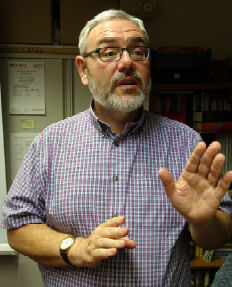
Frank Olding (above) was the guest speaker at
the Ralph Robinson Memorial Lecture (27th
September) – an annual lecture arranged by
Abertillery & District Museum. Mr Olding
talked about the 3rd Battalion the
Monmouthshire Regiment – the 3rd Mons –
and their movements and role in the First
World War. It was sobering to realise the
staggering number of men lost in battle and it
was all the more poignant for hearing the
stories of some of the individual soldiers. The
museum’s curator, Mr Don Bearcroft, gave a
vote of thanks following a lively question time
and said “We always enjoy Frank’s lectures
and this was certainly one of the best. I am
sure I speak for everyone when I say it was a
very emotional experience, hearing of the
sacrifice of so many men, men from our own
locality”.
Report by Jen Price
Mein Kampf by Sally Murphy
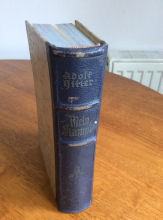 In March 2015 my sister
and I donated a copy of
Hitler’s, ‘Mein Kampf’
to the museum and it is
now on display in one of
the glass cabinets. This
In March 2015 my sister
and I donated a copy of
Hitler’s, ‘Mein Kampf’
to the museum and it is
now on display in one of
the glass cabinets. This
story was written about ‘Roving Reporter’, the
late Enid Dean, in the
April 2015 edition of the
newsletter but I thought
I would write the story again from my perspective
as the donor of the book especially given that I
have several unseen photos which I took before
handing the book over to the museum…
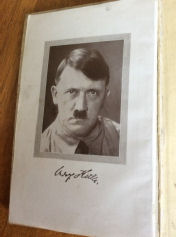 The book, written in
German of course, has a
picture of Hitler on the
inside cover and was
found by my father, Tom
Wayne (now deceased),
The book, written in
German of course, has a
picture of Hitler on the
inside cover and was
found by my father, Tom
Wayne (now deceased),
at 47 Penybont Road,
Abertillery. This
deceptively large house
had been bought by my
great-grandfather,
Thomas William Wayne,
for my grandparents,
George and Florence Wayne and they moved in
around 1947. My
grandparents ran a
dairy from this house
and my father also used
one of the rooms as a
storeroom for his
business as a plumbing
and heating engineer.
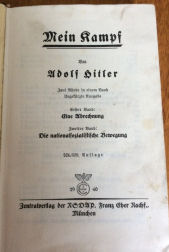 When my last
surviving grandparent
died in 1981, the house
passed to my father
who continued to use it
for many years until he
When my last
surviving grandparent
died in 1981, the house
passed to my father
who continued to use it
for many years until he
retired. After retiring, he decided to sell the house
and it was when he was emptying the house that he
came across the book which had a rather
interesting insert written, of course, in German.
During Hitler’s regime, German couples were
given a copy of Mein Kampf as a wedding gift and
this particular book was one such gift. As luck
would have it, my sister worked with someone
who was German and she very kindly translated it
for us. She told us that as she read it, it had made
her spine tingle!
The book’s insert (see below) translates as:-
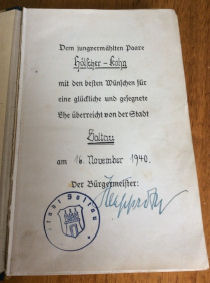
To the newly wed
couple hölscher & kohn with best
wishes for a
happy and
blessed marriage
Soltau
16th November
1940
The Mayor
Soltau is a mid-sized town in Lower Saxony,
Germany and we know the book was there on 16th
November 1940 and sometime between then and
1947 the book found its way to 47 Penybont
Road, Abertillery. My father told me he believed
the dairy at 47 Penybont Road had been a drinking
club prior to my grandparents moving in, so it’s
possible it was left there by a drinker at the club
but was it hölscher or kohn? And, if so, what were
they doing in Abertillery? Did they have their ‘happy ever after’? Or did they both perish in the
war and the book was found and brought back
from Germany by a British soldier as a sort of
morbid souvenir? Alas, we shall never know…!
As I get older I realize:
• I talk to myself because sometimes I need
expert advice.
• Sometimes I roll my eyes out loud.
• My people skills are just fine; it’s my
tolerance of idiots that needs work.
• The biggest lie I tell myself is “I don’t
need to write that down, I’ll remember it.”
• When I was a child I thought nap-time was
punishment, now it’s like a mini-vacation.
• The day the world runs out of wine is just
too terrible to contemplate.
• Even duct tape can’t fix stupid, but it can
muffle the sound.
• Wouldn’t it be great if we could put
ourselves in the dryer and come out
wrinkle-free and three sizes smaller?
• “Getting lucky” means walking into a
room and remembering why I’m there!
Local Voices
 The Ghost in the
Attic By Alison Williams
The Ghost in the
Attic By Alison Williams
Some of you may know of
my late father, Tom Wayne ‘the plumber’, he was well
known in Abertillery.
Back in the 1970’s he came home one day
laughing so much he couldn’t speak! When he
eventually managed to get his words out he
related the following….
He had been working in the attic of a terraced
house in Ebbw Vale. The adjoining house
next-door was undergoing extensive work, so
much so that a bedroom ceiling had been
removed which allowed my father, from his
vantage point in the attic, to see into a
bedroom of the house next-door.
While my father was working in the attic, two
people, a man and young lad, entered the
adjoining house and came up the stairs to the
bedroom with no ceiling. The older man
picked up a broom, gave it to the lad and told
him to sweep up. The older chap then left the
house, leaving the young lad alone in the
house.
Wanting to be friendly, my father called down
a greeting to the lad. Believing himself to be
alone, the young lad looked around startled.‘I’m up here’ dad called out trying to reassure
the boy. The young lad peered upwards but as
he was in the light and dad was in a darkened
attic, he was unable to see where the voice
was coming from! Dad watched on as the lad
crept towards the nearest wall, quietly placed
his broom against the wall and then slowly
backed out towards the bedroom door. Once
there he flung it open and ran down the stairs
as fast as his legs would carry him. Dad
heard the front door slam shut behind him and
he never saw the older man or the young lad
again!
 My father related this story to me many times
over the passing years and he could never do
so without tears of laughter rolling down his
cheeks!
My father related this story to me many times
over the passing years and he could never do
so without tears of laughter rolling down his
cheeks!
So if you are reading this and you recognise
yourself as the young lad in this tale, you can
finally rest assured
that you didn’t
encounter a ghost that
day; it was just my
dear old dad!
If you have a story to tell, don’t keep it to
yourself! Email it to me at
sallymurphy@talktalk.net, or drop a line to the
museum and see your story in print here!
Rocket Launch: October 11, 2017
SpaceX Falcon 9
EchoStar 105/SES-11
 On Wednesday 11th
October at 6:53pm
Florida time,
(23:53 BST), a
rocket was
launched from
Kennedy Space
Centre at Cape
Canaveral and my
daughter, Sarah,
was lucky enough
to be there to
witness it. Its
mission was to
launch a
communications
satellite into orbit
for SES and
Echostar.
On Wednesday 11th
October at 6:53pm
Florida time,
(23:53 BST), a
rocket was
launched from
Kennedy Space
Centre at Cape
Canaveral and my
daughter, Sarah,
was lucky enough
to be there to
witness it. Its
mission was to
launch a
communications
satellite into orbit
for SES and
Echostar.
The launch was notable because the company,
SpaceX, re-used a previously flown Falcon 9
first stage rocket. This first stage rocket has
once again been successfully landed back on
Earth to be reused again in the future. This
sets it apart from the rockets used in the
Apollo missions that took men to the moon
back in the 60’s and 70’s and could only be
used once. By re-using rockets like this, costs
can be significantly reduced and shows what a
long way we have come in the last fifty years.
Sarah videoed the launch and you can watch
the video on the museum’s Facebook page.
Report by Sally Murph
Museum Matters
Soldiers and sailors of the 18th century
In our museum collection are military items of the British forces such as: powder flasks, sabres, iron, stone musket balls and a 12 lb cannon ball. During Napoleonic Wars the iron works of South Wales were kept busy producing iron for cannons and also cannon balls. This work was so essential that Admiral Horatio Nelson made a surprise visit to Cyfarthfa Iron Works in recognition of its critical role in the war effort. Owner Richard Crawshay is said to have cried for joy and announced to the workmen "This is Nelson, shout you Beggars!"
The end of a war is always a test of the condition of any country, and when Britain and France made peace in 1763, 100,000 men returned to find work in their own country. Yet there was little trouble. These men again took up their occupations, and things went on much as before. This was a contrast to conditions existing after the Napoleonic War at the beginning of the following century and after the Great War of our own time.
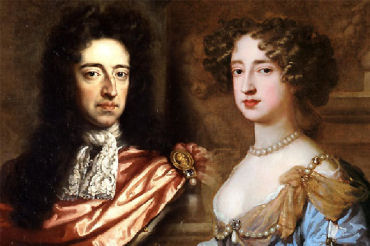 The real history of the British Army begins with the reign of William and Mary. Before this time soldiers were looked upon as personal retainers of the King, but, by the Mutiny Act of 1689, a standing army was recognised. The army was in constant use during the reigns of William and Anne, and recruiting was carried on in strange ways. "All idle, loose, and vagabond persons who have not wife or children" were to be seized and enlisted, also "young, fencible i.e. men who were capable of defending themselves and their countrymen, not having wife or children, who earn their living by daily wages or teemly i.e., profitable hire." The Mutiny Act of 1702 says that "All able-bodied men who had no lawful calling or occupation, or visible means of subsistence," were to be compelled to serve in the army.
The real history of the British Army begins with the reign of William and Mary. Before this time soldiers were looked upon as personal retainers of the King, but, by the Mutiny Act of 1689, a standing army was recognised. The army was in constant use during the reigns of William and Anne, and recruiting was carried on in strange ways. "All idle, loose, and vagabond persons who have not wife or children" were to be seized and enlisted, also "young, fencible i.e. men who were capable of defending themselves and their countrymen, not having wife or children, who earn their living by daily wages or teemly i.e., profitable hire." The Mutiny Act of 1702 says that "All able-bodied men who had no lawful calling or occupation, or visible means of subsistence," were to be compelled to serve in the army.
When recruits were won in this manner, when criminals, tramps, and debtors from prison were forced to serve, it was to be expected that there would be many deserters. At one time no fewer than 1500 deserters from Marlborough's army were found hiding in Dutch towns. It is not to be wondered at that volunteers for the army were scarce. At this time service with the colours was v intensely unpopular for several reasons. The officials in England cheated the officers, and the officers in their turn cheated the men. Pay was often months and even years in arrears, though it was only 8d. a day. Soldiers could not march for want of shoes; they were starved for want of food and often died for want of medicine. There were no pensions, and only the Chelsea Hospital existed for those with more than twenty years' service, and for those who had lost a limb.
When William had to face the rebellion raised against him in Ireland by James II in 1689, his best troops were in Holland with Marlborough, and new recruits were rushed to Ireland. Many were without uniform ; some were without muskets; and others could not fire those they had. There were practically no horses or harness for the artillery. No arrangements were made for supplying food and on the march from Dundalk all ranks nearly starved. Everything in the Dundalk camp was bad, and, as a result, fever broke out. Of an army of 14,000 men, 6300 died.
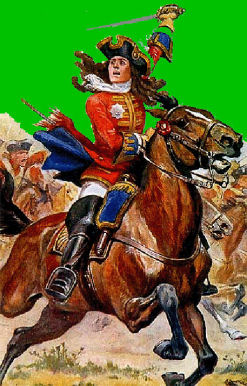
Marlborough, like every great general, did everything he could for his men, and under him the army was greatly improved. But he seems to have been powerless to get proper pay for his soldiers. We read that in 1691 : "Six battalions in Ghent had orders to march out and join the main body, but as we were about to march out of the city, the city gates were shut against us by the people of the place, because we had no money to pay our quarters. Our paymaster-general had gone to Holland to get money on credit". To one regiment Queen Mary sent £1000 out of her own money. This regiment received in five years £3000 instead of £18,000 which was due to it. Marlborough wrote: “it must needs be a very great hardship to have so great an arrear, and that it would much contribute to the service if some part of it were paid, to enable the Colonel the better to clothe his regiment and the officers to support themselves in the Army”.
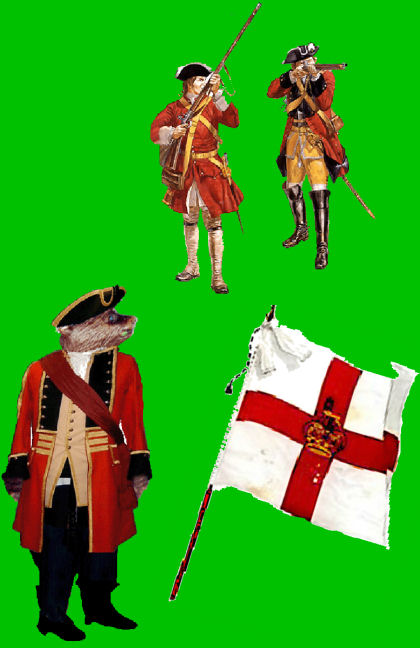 The weapons of the soldiers were flint-lock muskets, socket bayonets, and swords; pikes and matchlocks were disappearing. The pictures of Marlborough's soldiers show us men wearing long scarlet coats, gaiters, shoes, cocked hats, and long pigtails tied with bows of ribbon.
The weapons of the soldiers were flint-lock muskets, socket bayonets, and swords; pikes and matchlocks were disappearing. The pictures of Marlborough's soldiers show us men wearing long scarlet coats, gaiters, shoes, cocked hats, and long pigtails tied with bows of ribbon.
Don Bearcroft Curator
